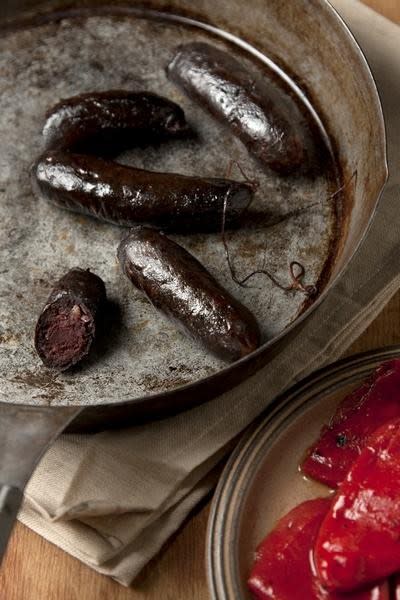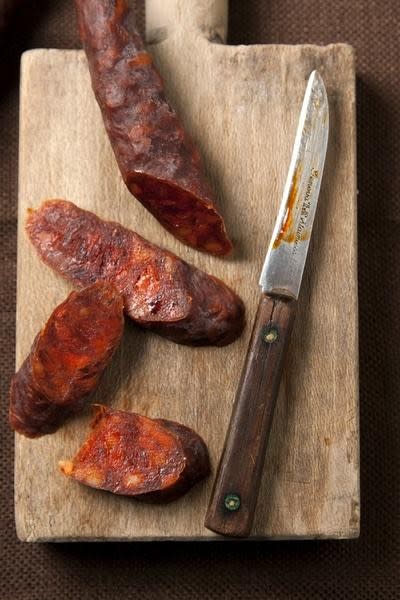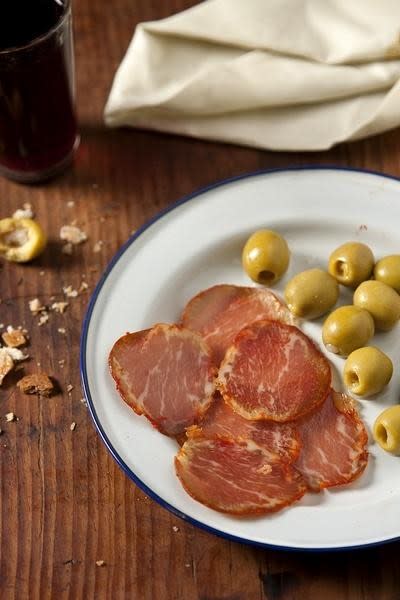Be a Genius at Spanish Cured Meats
The sausages and cured meats that Spain produces are a testament to the edible magic that results when a pig meets spices and a little bit of curing time.
See the Complete Guide to Spanish Cured Meats

Jamon Ibérico de Bellota
Rare, expensive, and extraordinary, this ham made from the hocks of pata negra pigs has only recently become available in the United States. (Legally, that is—for many travelers to Spain, smuggling jamon ibérico home through customs was an essential part of the trip.) The robust, funky meat—streaked with sweet, nutty fat—gets its characteristic flavor from a combination of the pigs’ all-acorn diet, and their moderately active life roaming free-range through oak forests on the Spain-Portugal border.
Read More: How to Smuggle a Ham

Morcilla
Spain’s blood sausage earned its reputation as one of the most accessible black puddings thanks to the inclusion of a starchy filler, most commonly rice, which mimics the mouthfeel of a traditional meat sausage. The pork blood is flavored with garlic, onion, and pimentón; when sliced and fried in olive oil, the edges crisp up in a rich textural counterpoint to the soft interior.
Read More: Know Your Avocados, A Guide to 9 Varieites

Chorizo
Spain’s most famous sausage is also its least consistent: “chorizo” is a catchall term that encompasses virtually any sausage made from ground pork mixed with a generous dose of either sweet or spicy pimentón. Everything else—the coarseness of the grind; sausage length, width, density and curing time; any additional ingredients—can vary tremendously from region to region and kitchen to kitchen. The most popular version is a lean, dry, austere sausage made from pork, pimentón, and salt; it’s equally tasty sliced and paired with cheese, or chopped and fried in olive oil, served with bread for sopping up the spicy, flavorful drippings.
Read More: The Spring Produce Guide to Fresh Herbs

Jamon Serrano
The renowned Spanish take on prosciutto—a dry-cured ham that’s sliced thin enough for the soft fat to melt on the tongue—cures in salt for two weeks, and then is stored in towering piles for upwards of two months. The resulting ham, flat and dense from the pressure of being stacked, is sweet and fatty. Enhance the experience by bringing out acidic accompaniments like peppers, membrillo (quince paste), or a crisp, fruity glass of sangria.
Read More: Middle Eastern Meze

Lomo Embuchado
Considered one of the finest forms of Spanish charcuterie, lomo embuchado—a dry-cured pork tenderloin dusted with pimentón, wrapped, and set to cure for two months or more—is meaty, lean, and intensely flavorful. Served sliced thin to enhance the enjoyably chewy texture, it’s at its best paired with something fruity, fatty, or both: drizzled with olive oil, or eaten in the same bite as an olive or piquillo pepper.
Read More: Cocktails for Each Sign of the Zodiac

Lomo Embuchado Ibérico de Bellota
If lomo embuchado is a king among cured meats, the lomo embuchado ibérico de bellota is an emperor. It’s not just any pig that gets elevated to this fate: this sausage comes from the wild-roaming, acorn-fed patas negras whose hocks are cured for the rare, expensive, and extraordinary jamón ibérico de bellota. Richer in both color and marbling than its cousin, lomo embuchado ibérico de bellota has a dense, nutty flavor that holds its own without accompaniments.

Butifarra
This Catalonian boiled sausage of fine-ground lean pork is similar in taste and texture to American soft salami, but with a garlicky kick that puts it right at home against other vivid flavors: pickles, sharp cheeses, and spicy peppers are perfect pairs. Slice it in rounds and put it on bread, or simply chop it into bite-sized pieces and nibble it on its own.

Fuet
Another Catalonian sausage, fuet (which means “whip” in the local dialect) is thin and long, similar in texture to chorizo but with the heavy dose of pimentón replaced with fiery black pepper. Dry-cured and intensely flavorful, it’s traditionally served whole on a wooden board, accompanied by a sharp knife for diners to slice their own portions.



